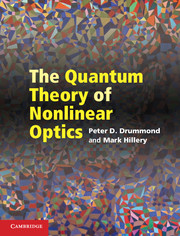Book contents
- Frontmatter
- Contents
- Preface
- Introduction
- 1 Classical nonlinear optics
- 2 Field quantization
- 3 Quantized fields in dielectric media
- 4 Microscopic description of media
- 5 Coherence and quantum dynamics in simple systems
- 6 Decoherence and reservoirs
- 7 Phase-space distributions
- 8 Single-mode devices
- 9 Degenerate parametric oscillator
- 10 Quantum field dynamics
- 11 Quantum propagation in fibers and waveguides
- 12 Quantum information
- List of symbols
- Index
- References
8 - Single-mode devices
Published online by Cambridge University Press: 05 May 2014
- Frontmatter
- Contents
- Preface
- Introduction
- 1 Classical nonlinear optics
- 2 Field quantization
- 3 Quantized fields in dielectric media
- 4 Microscopic description of media
- 5 Coherence and quantum dynamics in simple systems
- 6 Decoherence and reservoirs
- 7 Phase-space distributions
- 8 Single-mode devices
- 9 Degenerate parametric oscillator
- 10 Quantum field dynamics
- 11 Quantum propagation in fibers and waveguides
- 12 Quantum information
- List of symbols
- Index
- References
Summary
The simplest open, nonlinear optical system consists of a single bosonic mode with nonlinear self-interactions coupled to driving fields and reservoirs. In this chapter, we will examine a number of systems of this type using the methods that have been developed in the preceding chapters. Systems of this type can exhibit a variety of interesting physical effects. For example, in the case of a driven nonlinear oscillator, there can be more than one steady state (bistability), and quantum statistical effects can manifest themselves by affecting the stability of these states. Other quantum statistical effects have also been predicted in a variety of related systems – such as photon anti-bunching, squeezing and changes to spectra. In general, the size of these effects scales inversely with the size of the system. This ‘system size’ refers to a threshold photon number, a number of atoms, or some similar quantity.
The nature of the steady states themselves can become less than straightforward. Nonequilibrium dissipative systems, of which the systems considered in this chapter are examples, have parameters that describe the energy input to the system, and their steady states depend on these parameters. When driven far from equilibrium, such systems can exhibit bifurcations in their steady states. In more complex cases, this eventually leads to periodic oscillations and chaos. Devices like this can be realized with multiple types of nonlinearity, ranging from nonlinear dielectrics through to cavity QED (with near-resonant atoms), cavity optomechanics (with nanomechanical oscillators) and circuit QED (with superconducting Josephson junctions).
We will start with cases where all the interactions are with the reservoirs, which may be linear or nonlinear, while the cavity itself is harmonic in its response.
- Type
- Chapter
- Information
- The Quantum Theory of Nonlinear Optics , pp. 256 - 282Publisher: Cambridge University PressPrint publication year: 2014



